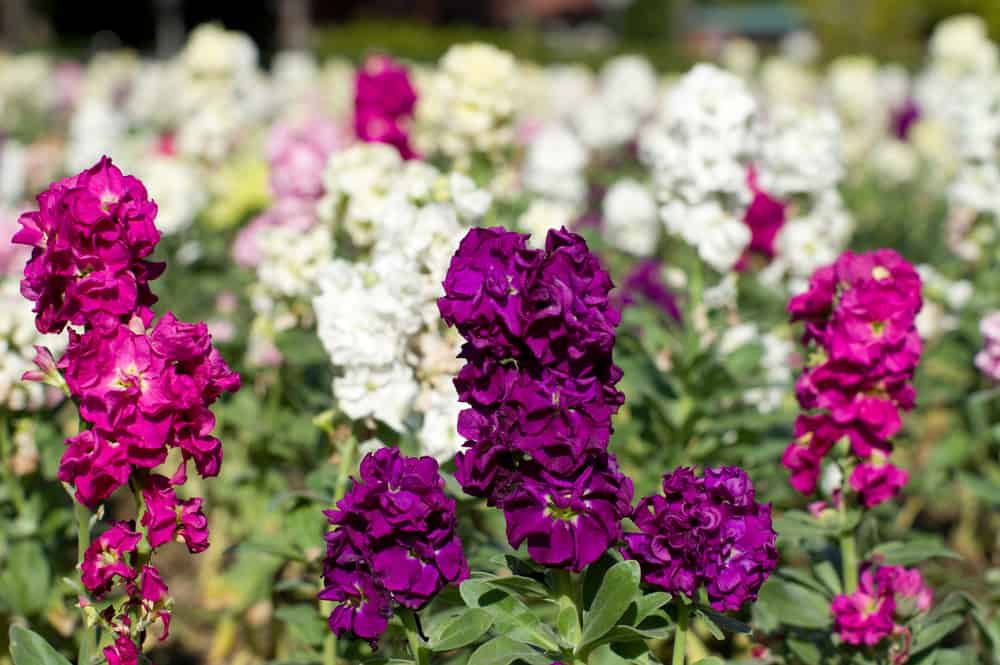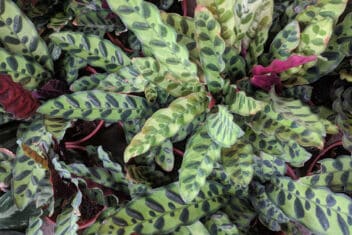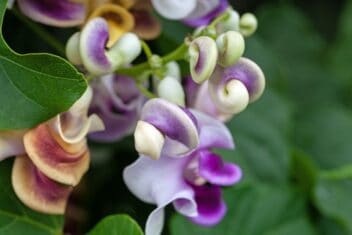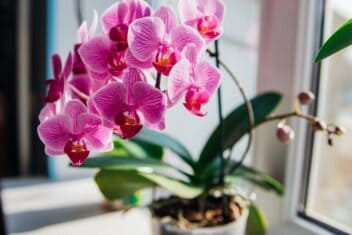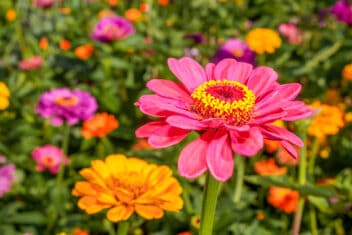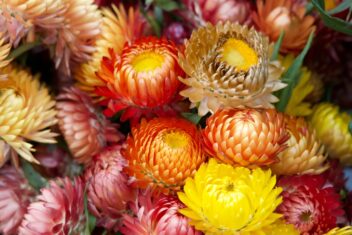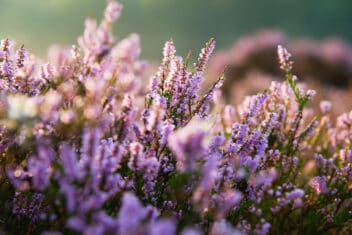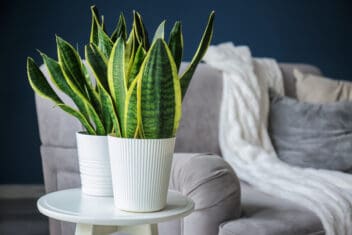Stock flowers come in many beautiful colors and give off an intense fragrance. These plants are a cottage garden favorite, with long stalks of ruffled blossoms. These flowers are ideal for bouquets, plus they’re edible. You can use them in tea, salads, sandwiches, and more.
There are numerous of hybrid and cultivars to choose from, from plants that grow between 9-36 inches tall with colors from pure white to deep purple.
Discover More About Stock Flowers
Stocks (Matthiola incana) have dense flower buds with a heavy sweet, floral fragrance. The stems are long and sturdy, so the flowers sit upright among green foliage.
Also known as gillyflower or hoary stock, this flowering plant is part of the Brassicaceae family, which includes cabbages, kale, broccoli, and Brussels sprouts.
You can plant these flowers in raised beds or keep them in containers.
Stock flowers bloom in early spring and summer until the temperature exceeds 60°F. This is when the plant will stop producing flowers, as it’s too hot.
You can grow stock flowers are annual, biennial, or perennial, which makes it ideal for gardeners in different regions. The perfect climate is between USDA Hardiness Zones 7-10, though they can be planted in colder regions as annuals.
Best Stock Flower Cultivars
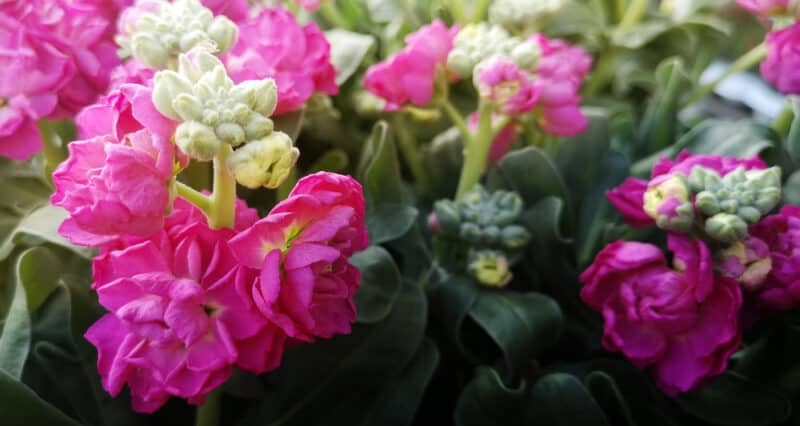
There are many excellent cultivars out there. Many cultivars come in color mixes rather than as single colors. Here are a few of our favorites:
Anytime
With deep purple blossoms, ‘Anytime Lavender’ stands out in the garden. You can also find it in a mix of yellow, red, white, burgundy, and lavender, but the single hue would make a big statement with its 24-inch tall stems.
If you’d like to add it to your garden, visit Amazon to grab a pack of seeds.
Asa No Kagayaki
‘Asa No Kagayaki’ means “morning glow” in Japanese and it’s perfectly named. The pale pink blossoms have a golden center, like the pink hue of the early morning sunrise. This is a single stem variety and grows to about 18 inches tall.
Cinderella
‘Cinderella’ is the most fairy-tale like series of them all. This dwarf series produces heavily fragrant double blooms, which can transform a garden space. The series comes in pastel or vivid colo mixes.
Legacy
‘Legacy’ grows to two feet tall. An excellent option for borders or as some height in the garden. The plant produces showy double flowers in hues of pink and purple.
‘Antique Pink’ stock flowers are perfect for bouquets. Their stems are long and robust, so all they need is a vase and some water. They produce an eye-catching pink to white flower with a green center. This cultivar only produces one flower stalk per plant, so buy several.
Don’t pinch this plant because then it won’t flower.
Starlight Sensation
‘Starlight Sensation’ plants are large and grow up to 18 inches. This series comes in lilac, fuchsia, and white hues. Most come in mixes rather than as a single color, and you might get differing colors even if you choose a specific one.
White Surf
If you want something a bit more subtle and classic, check out ‘White Surf.’ The snow-white blossoms grow on 18-inch stalks and have a distinct clove-like scent. This is an especially good option for eating, as they have a nutty flavor.
Planting Stocks
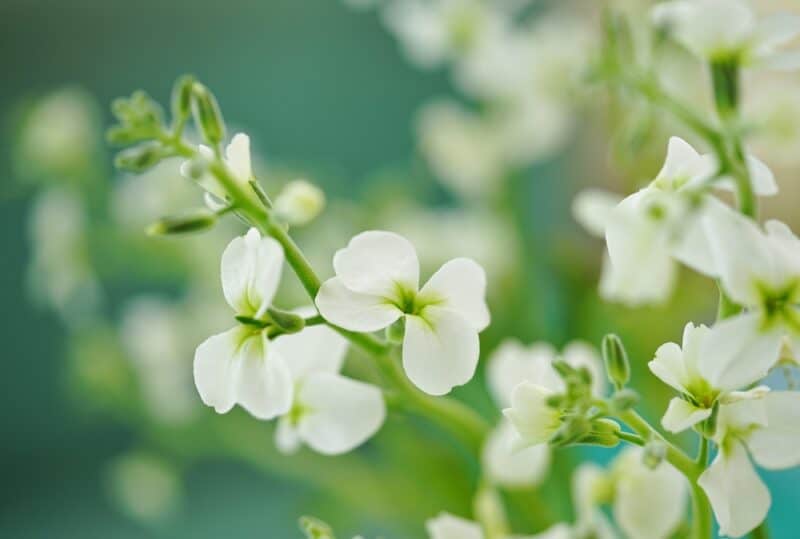
There are two ways to plant stock flowers: by seedlings or seeds.
The most successful method for planting is using seedlings, as it has a higher success rate. It’s also more expensive, but it might be worth the trade-off if you have trouble starting seeds.
Dig a hole large enough for the seedlings and place them two in the soil. Be careful not to place the seedlings too close together. Most need to be spaced somewhere between 9-18 inches apart. Water well.
For planting seeds, you can sow them indoors to allow them time to germinate and grow if you live in an area with a short growing season. If you have four months of growing time, go ahead and plant directly outdoors if you want.
You can always start indoors if you want a head-start, no matter where you live.
Put seeds in soil or potting mix and cover with an eighth inch of soil. Water thoroughly but carefully. If you use a stream of water, it can displace the seeds. So use a spray bottle to moisten the soil.
Once the seeds germinate, which takes about two weeks, you can cut down the watering time.
After the last frost in spring, you can transplant the seeds to outdoor soil if you started them inside.
Be sure to harden them off for at least a week to transition them to the outside environment. They’ve been protected indoors with no exposure to wind or harsh temperatures and need time to adjust to the outdoors.
Hardening off involves giving the plant an hour of exposure outside and then bringing it back indoors. The next day, add an hour. Do three hours of exposure on the third day, and so on. After a week, plant them in place.
Growing Stock Flowers
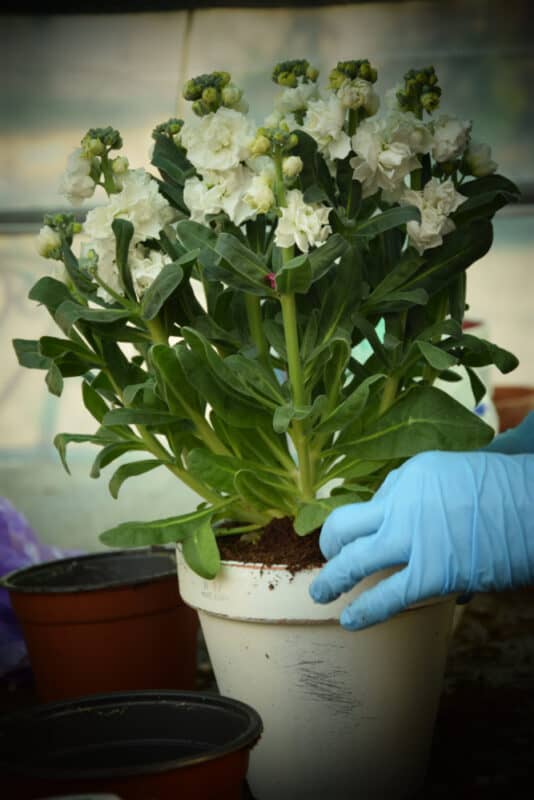
Stock flowers need full to partial sunlight to thrive. Don’t place them in a spot blocked by walls, fences, or other plants. They need at least three hours of sunlight daily, but six or more is preferable.
Give them well-draining soil that has a neutral pH. Commercial potting soil is excellent for container growing. You might need to amend your garden soil. If so, use well-rotted manure or compost to loosen up soil, improve drainage, and add nutrients.
Stocks can’t survive temperatures below about 30°F, but they also need temperatures under 60°F to begin flowering. Likewise, stock flowers don’t like hot, muggy climates.
Don’t overwater the plants; they could stop producing flowers, and the leaves will droop and turn yellow. These plants need about an inch of water per week. Use a rain gauge to determine how much moisture they receive naturally and supplement if necessary.
Fertilizer isn’t necessary for stock flowers. You can add more mulch or manure or compost to prevent weed growth or ensure your flowers are high quality.
The only pruning task is to deadhead during the flowering season. Deadheading encourages new growth and fresh blossoms. You can do this as soon as the flowers start to fade.
Common Pests and Diseases
These fragrant flowers are pretty, smell marvelous, and taste fantastic. And apparently, pests agree. Aphids, scale, cabbage white caterpillars, and flea beetles will all feed on them.
Aphids
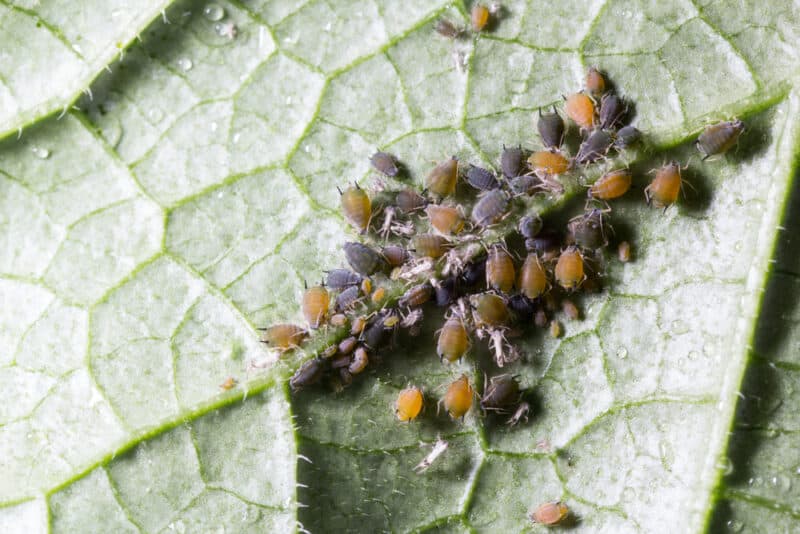
Aphids are sap-sucking little creatures that love to snack on your flowers. If you have an aphid infestation, they can suck all the nutrients from the plants and ruin the petals. Typically, the most obvious symptom of these pests is the sticky substance they leave behind.
They often attack the buds and stems of stock flowers. Early growing times are the prime occasion for aphids to infest your plants. You can remove these pests with neem oil or a combination of soap and water.
If this doesn’t work, visit our guide for plenty of tips.
Cabbage White Caterpillars

Cabbage white caterpillars are common on stock plants and all brassicas. Even though the adult butterfly is cute, when fully matured, they can be deadly for your flowers. The larvae often can be seen moving across the leaves or stems of your plants.
Adult butterflies lay eggs in spring and autumn, so you need to be vigilant around these times.
An excellent prevention technique is to place fleece or netting over the flowers as they grow. This will stop cabbage white caterpillars from attacking as your flowers are blooming. Visit our guide for many more tips for controlling these common pests.
Flea Beetles
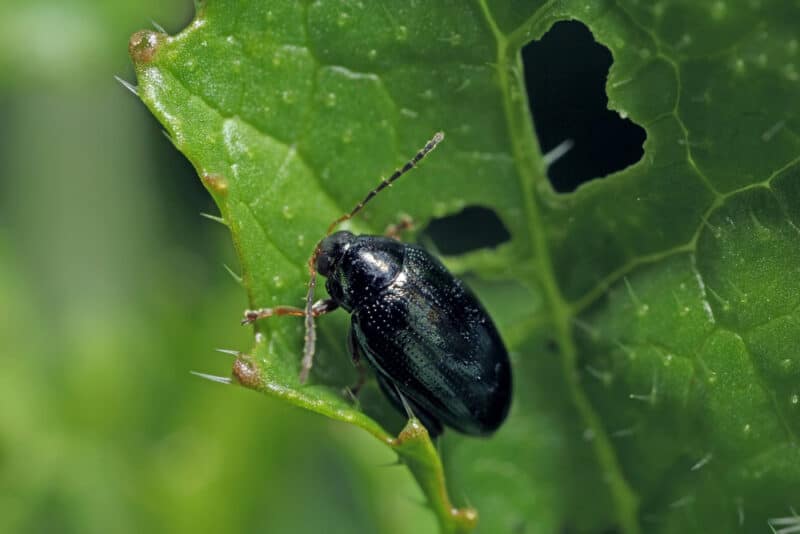
Flea beetles are tiny, with shiny black shells. They can jump quickly when approached by predators, so they can be easily scared off if you approach them.
The best way to tell if you have a flea beetle problem is to look for lots of little shotholes in the leaves. If you see these holes, visit our guide to learn how to control them.
Scale

Scale looks like a disease, but it’s actually a pest. These insects are flat and often have a white or gray waxy coating. These can be scraped of or you can wipe their shell with a cotton swab dipped in isopropyl alcohol.
This removes the protective coating and leaves them exposed.
For more tips, check out our guide.
Stock Flower Diseases
The most common diseases on stocks are fungal. You can avoid many of these by watering on the soil, not on the leaves, and leaving space between plants. Fungicide can also be used to treat some of these issues.
Gray mold (Botrytis spp.), Sclerotinia rot, downy mildew, fusarium wilt, verticillium wilt, black rot (Xanthomonas campestris pv. campestris), and Turnip Mosaic Virus (TMV).
Gray mold attacks during cold and wet weather, which is why it’s more common in the spring and fall. It appears as wilted flowers before the entire plant wilts into a gray moldy mass.
Ensure that the flowers aren’t overcrowded and deadhead regularly. This improves air circulation. Fungicide is the only treatment to stop gray mold, but you need to catch it early. Use a copper-based fungicide every two weeks until symptoms are gone.
Mosaic virus starts as mottled yellow on the leaves of the plant. There is no cure and you’ll have to pull the plant to prevent it from spreading to all your brassicas.
Harvesting and Using Stocks in the Kitchen
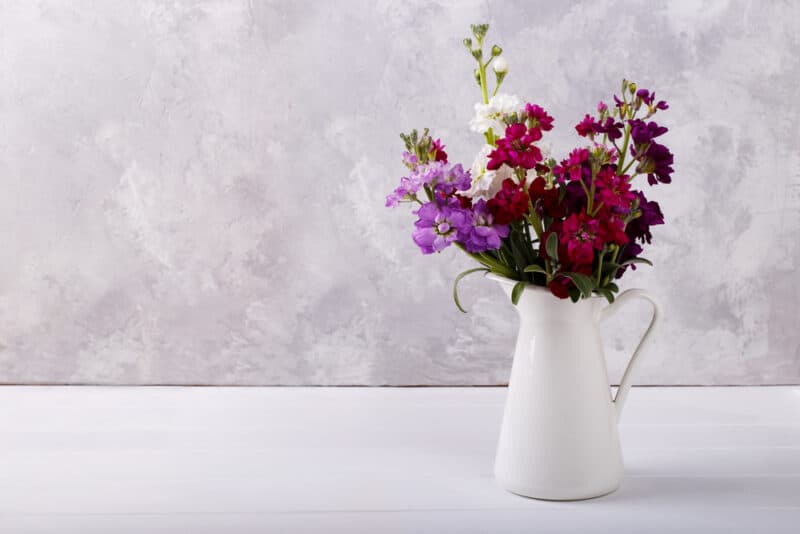
Matthiola incana is mainly harvested for bouquets, but the flowers are delicious. They contain antioxidant properties, so they’re healthy, too.
Plus, this marvelous plant is full of omega-3 oils that have been studied for their health benefits.
There are a few ways to enjoy these excellent health benefits of stock flowers. First, you can dry the flowers and brew them into tea. Alternatively, you can use the flowers to add garnish to your summer salad and place them on desserts.
If you don’t want to consume stock flowers, arrange them into a bouquet. You can keep the flowers at home or give them to a friend.
The choice is yours!
